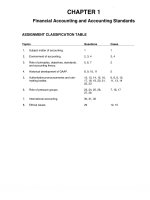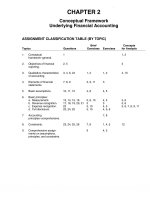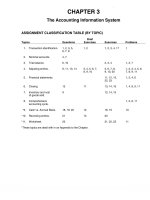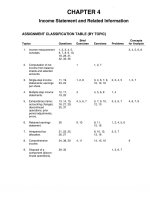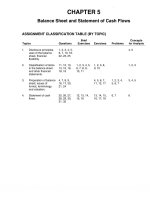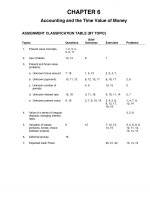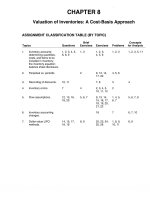Intermediate accounting 14th kieso chapter 14 solution manual
Bạn đang xem bản rút gọn của tài liệu. Xem và tải ngay bản đầy đủ của tài liệu tại đây (674.2 KB, 92 trang )
To download more slides, ebook, solutions and test bank, visit
CHAPTER 14
Long-Term Liabilities
ASSIGNMENT CLASSIFICATION TABLE (BY TOPIC)
Topics
Questions
Brief
Exercises
Exercises
Problems
Concepts
for Analysis
1, 2
10, 11
1, 2
1.
Long-term liability;
classification; definitions.
1, 10,
14, 22
2.
Issuance of bonds; types
of bonds.
2, 3, 4, 9,
10, 11
1, 2, 3, 4,
5, 6, 7
3, 4, 5, 6,
7, 8, 9, 10,
11
1, 2, 3, 4,
5, 6, 7, 10
1, 2, 5
3.
Premium and discount;
amortization schedules.
5, 6, 7,
8, 11
3, 4, 6, 7,
8, 10
4, 5, 6, 7,
8, 9, 10,
11, 13,
14, 15
1, 2, 3, 4,
5, 6, 7,
10, 11
1, 2
4.
Retirement and refunding
of debt.
12, 13
11
12, 13,
14, 15
2, 4, 5,
6, 7, 10
2, 3
5.
Imputation of interest on
notes.
14, 15, 16,
17, 18
12, 13,
14, 15
16, 17, 18
8, 9
6.
Fair value option.
19, 20
16
19
7.
Disclosures of long-term
obligations.
21, 22,
23, 24
9
20
10
Troubled debt
restructuring.
25, 26, 27,
28, 29, 30
21, 22, 23,
24, 25,
26, 27
12, 13,
14, 15
*8.
1, 3, 4
*This material is discussed in the Appendix to the Chapter.
Copyright © 2011 John Wiley & Sons, Inc.
Kieso, Intermediate Accounting, 14/e, Solutions Manual
(For Instructor Use Only)
14-1
To download more slides, ebook, solutions and test bank, visit
ASSIGNMENT CLASSIFICATION TABLE (BY LEARNING OBJECTIVE)
Brief
Exercises
Learning Objectives
Exercises
Problems
1.
Describe the formal procedures associated
with issuing long-term debt.
2.
Identify various types of bond issues.
3.
Describe the accounting valuation
for bonds at date of issuance.
1, 2, 3, 4, 5,
6, 7, 8
3, 4, 5, 6, 7, 8,
9, 10, 11, 12,
13, 14, 15
1, 2, 3, 4, 5,
6, 7, 10
4.
Apply the methods of bond discount
and premium amortization.
2, 3, 4, 5, 6,
7, 8, 10
3, 4, 5, 6, 7, 8,
9, 10, 12, 13,
14, 15
1, 2, 3, 4, 5,
6, 7, 10, 11
5.
Describe the accounting for the
extinguishment of debt.
11
12, 13, 14, 15
2, 4, 5, 6,
7, 10
6.
Explain the accounting for long-term
notes payable.
12, 13, 14, 15
16, 17, 18
8, 9
7.
Describe the accounting for the fair value
option.
16
19
8.
Explain the reporting of off-balance sheet
financing arrangements.
9.
Indicate how to present and analyze
long-term debt.
9
20
4, 10
21, 22, 23,
24, 25
26, 27
12, 13, 14
*10.
14-2
Describe the accounting for debt
restructuring.
Copyright © 2011 John Wiley & Sons, Inc.
1, 2
Kieso, Intermediate Accounting, 14/e, Solutions Manual
(For Instructor Use Only)
To download more slides, ebook, solutions and test bank, visit
ASSIGNMENT CHARACTERISTICS TABLE
Item
Description
Level of
Difficulty
Time
(minutes)
E14-1
E14-2
E14-3
E14-4
E14-5
E14-6
E14-7
E14-8
E14-9
E14-10
E14-11
E14-12
E14-13
E14-14
E14-15
E14-16
E14-17
E14-18
E14-19
E14-20
*E14-21
*E14-22
*E14-23
*E14-24
*E14-25
*E14-26
*E14-27
Classification of liabilities.
Classification.
Entries for bond transactions.
Entries for bond transactions—straight-line.
Entries for bond transactions—effective-interest.
Amortization schedule—straight-line.
Amortization schedule—effective-interest.
Determine proper amounts in account balances.
Entries and questions for bond transactions.
Entries for bond transactions.
Information related to various bond issues.
Entry for retirement of bond; bond issue costs.
Entries for retirement and issuance of bonds.
Entries for retirement and issuance of bonds.
Entries for retirement and issuance of bonds.
Entries for zero-interest-bearing notes.
Imputation of interest.
Imputation of interest with right.
Fair value option.
Long-term debt disclosure.
Settlement of debt.
Term modification without gain—debtor’s entries.
Term modification without gain—creditor’s entries.
Term modification with gain—debtor’s entries.
Term modification with gain—creditor’s entries.
Debtor/creditor entries for settlement of troubled debt.
Debtor/creditor entries for modification of troubled debt.
Simple
Simple
Simple
Simple
Simple
Simple
Simple
Moderate
Moderate
Moderate
Simple
Simple
Simple
Simple
Simple
Simple
Simple
Moderate
Simple
Simple
Moderate
Moderate
Moderate
Moderate
Moderate
Simple
Moderate
15–20
15–20
15–20
15–20
15–20
15–20
15–20
15–20
20–30
15–20
20–30
15–20
15–20
12–16
10–15
15–20
15–20
15–20
10–15
10–15
15–20
20–30
25–30
25–30
20–30
15–20
20–25
P14-1
P14-2
P14-3
P14-4
Analysis of amortization schedule and interest entries.
Issuance and retirement of bonds.
Negative amortization.
Issuance and retirement of bonds; income statement
presentation.
Comprehensive bond problem.
Issuance of bonds between interest dates, straight-line,
retirement.
Entries for life cycle of bonds.
Entries for zero-interest-bearing note.
Entries for zero-interest-bearing note; payable
in installments.
Comprehensive problem; issuance, classification,
reporting.
Effective-interest method.
Simple
Moderate
Moderate
Simple
15–20
25–30
20–30
15–20
Moderate
Moderate
50–65
20–25
Moderate
Simple
Moderate
20–25
15–25
20–25
Moderate
20–25
Moderate
40–50
P14-5
P14-6
P14-7
P14-8
P14-9
P14-10
P14-11
Copyright © 2011 John Wiley & Sons, Inc.
Kieso, Intermediate Accounting, 14/e, Solutions Manual
(For Instructor Use Only)
14-3
To download more slides, ebook, solutions and test bank, visit
ASSIGNMENT CHARACTERISTICS TABLE (Continued)
Item
Description
Level of
Difficulty
Time
(minutes)
*P14-12
*P14-13
*P14-14
Debtor/creditor entries for continuation of troubled debt.
Restructure of note under different circumstances.
Debtor/creditor entries for continuation of troubled debt
with new effective-interest.
Moderate
Moderate
Complex
15–25
30–45
40–50
CA14-1
Bond theory: balance sheet presentations, interest rate,
premium.
Bond theory: price, presentation, and retirement.
Bond theory: amortization and gain or loss recognition.
Off-balance-sheet financing.
Bond issue, ethics.
Moderate
25–30
Moderate
Simple
Moderate
Moderate
15–25
20–25
20–30
23–30
CA14-2
CA14-3
CA14-4
CA14-5
14-4
Copyright © 2011 John Wiley & Sons, Inc.
Kieso, Intermediate Accounting, 14/e, Solutions Manual
(For Instructor Use Only)
To download more slides, ebook, solutions and test bank, visit
SOLUTIONS TO CODIFICATION EXERCISES
CE14-1
Master Glossary
(a)
An obligation is callable at a given date if the creditor has the right at that date to demand, or to
give notice of its intention to demand, repayment of the obligation owed to it by the debtor.
(b)
The interest rate that results from a process of approximation (or imputation) required when the
present value of a note must be estimated because an established exchange price is not determinable and the note has no ready market.
(c)
Long-term obligations are those scheduled to mature beyond one year (or the operating cycle, if
applicable) from the date of an entity’s balance sheet.
(d)
The rate of return implicit in the loan, that is, the contractual interest rate adjusted for any not deferred loan fees or costs, premium, or discount existing at the origination or acquisition of the loan.
CE14-2
According to FASB ASC 470-10-50-1 (Disclosure of Long-Term Obligations):
The combined aggregate amount of maturities and sinking fund requirements for all long-term borrowings
shall be disclosed for each of the five years following the date of the latest balance sheet presented.
(See Section 505-10-50 for disclosure guidance that applies to securities, including debt securities.)
See Example 3 (Paragraph 470-10-55-10) for an illustration of this disclosure requirement.
CE14-3
According of FASB ASC 470-10-45-1 (Classification of Debt that Includes Covenants):
Some long-term loans contain certain covenants that must be met on a quarterly or semiannual basis.
If a covenant violation occurs that would otherwise give the lender the right to call the debt, a lender may
waive its call right arising from the current violation for a period greater than one year while retaining
future covenant requirements. Unless facts and circumstances indicate otherwise, the borrower shall
classify the obligation as noncurrent, unless both of the following conditions exist:
(a)
A covenant violation that gives the lender the right to call the debt has occurred at the balance
sheet date or would have occurred absent a loan modification.
(b)
It is probable that the borrower will not be able to cure the default (comply with the covenant) at
measurement dates that are within the next 12 months.
See Example 1 (paragraph 470-10-55-2) for an illustration of this classification guidance.
CE14-4
According to FASB ASC 470-10-S99-2 (SAB Topic 4.A, Subordinated Debt):
Subordinated debt may not be included in the stockholders’ equity section of the balance sheet. Any
presentation describing such debt as a component of stockholder’s equity must be eliminated. Furthermore, any caption representing the combination of stockholder’s equity and only subordinated debts must
be deleted.
Copyright © 2011 John Wiley & Sons, Inc.
Kieso, Intermediate Accounting, 14/e, Solutions Manual
(For Instructor Use Only)
14-5
To download more slides, ebook, solutions and test bank, visit
ANSWERS TO QUESTIONS
1. (a)
Funds might be obtained through long-term debt from the issuance of bonds, and from the
signing of long-term notes and mortgages.
(b)
A bond indenture is a contractual agreement (signed by the issuer of bonds) between the
bond issuer and the bondholders. The bond indenture contains covenants or restrictions for
the protection of the bondholders.
(c)
A mortgage is a document which describes the security for a loan, indicates the conditions
under which the mortgage becomes effective (that is, conditions of default), and describes
the rights of the mortgagee under default relative to the security. The mortgage accompanies a formal promissory note and becomes effective only upon default of the note.
2. If the entire bond matures on a single date, the bonds are referred to as term bonds. Mortgage
bonds are secured by real estate. Collateral trust bonds are secured by the securities of other
corporations. Debenture bonds are unsecured. The interest payments for income bonds depend on
the existence of operating income in the issuing company. Callable bonds may be called and
retired by the issuer prior to maturity. Registered bonds are issued in the name of the owner and
require surrender of the certificate and issuance of a new certificate to complete the sale. A bearer
or coupon bond is not recorded in the name of the owner and may be transferred from one investor
to another by mere delivery. Convertible bonds can be converted into other securities of the issuing
corporation for a specified time after issuance. Commodity-backed bonds (also called asset-linked
bonds) are redeemable in measures of a commodity. Deep-discount bonds (also called zerointerest bonds) are sold at a discount which provides the buyer’s total interest payoff at maturity.
3. (a)
Yield rate—the rate of interest actually earned by the bondholders; it is synonymous with the
effective and market rates.
(b)
Nominal rate—the rate set by the party issuing the bonds and expressed as a percentage of
the par value; it is synonymous with the stated rate.
(c)
Stated rate—synonymous with nominal rate.
(d)
Market rate—synonymous with yield rate and effective rate.
(e)
Effective rate—synonymous with market rate and yield rate.
4. (a)
Maturity value—the face value of the bonds; the amount which is payable upon maturity.
(b)
Face value—synonymous with par value and maturity value.
(c)
Market value—the amount realizable upon sale.
(d)
Par value—synonymous with maturity and face value.
5. A discount on bonds payable results when investors demand a rate of interest higher than the rate
stated on the bonds. The investors are not satisfied with the nominal interest rate because they
can earn a greater rate on alternative investments of equal risk. They refuse to pay par for the
bonds and cannot change the nominal rate. However, by lowering the amount paid for the bonds,
investors can alter the effective rate of interest. A premium on bonds payable results from the
opposite conditions. That is, when investors are satisfied with a rate of interest lower than the rate
stated on the bonds, they are willing to pay more than the face value of the bonds in order to
acquire them, thus reducing their effective rate of interest below the stated rate.
14-6
Copyright © 2011 John Wiley & Sons, Inc.
Kieso, Intermediate Accounting, 14/e, Solutions Manual
(For Instructor Use Only)
To download more slides, ebook, solutions and test bank, visit
Questions Chapter 14 (Continued)
6. Discount (premium) on bonds payable should be reported in the balance sheet as a direct
deduction from (addition to) the face amount of the bond. Both are liability valuation accounts.
7. Bond discount and bond premium may be amortized on a straight-line basis or on an effectiveinterest basis. The profession recommends the effective-interest method but permits the straightline method when the results obtained are not materially different from the effective-interest
method. The straight-line method results in an even or average allocation of the total interest over
the life of the notes or bonds. The effective-interest method results in an increasing or decreasing
amount of interest each period. This is because interest is based on the carrying amount of the
bond issuance at the beginning of each period. The straight-line method results in a constant
dollar amount of interest and an increasing or decreasing rate of interest over the life of the bonds.
The effective-interest method results in an increasing or decreasing dollar amount of interest and a
constant rate of interest over the life of the bonds.
8. The annual interest expense will decrease each period throughout the life of the bonds. Under the
effective-interest method the interest expense each period is equal to the effective or yield interest
rate times the book value of the bonds at the beginning of each interest period. When bonds are
sold at a premium, their book value declines to face value over their life; therefore, the interest
expense declines also.
9. Bond issuance costs should be debited to a deferred charge account for Unamortized Bond Issue
Costs and amortized over the life of the issue, separately from but in a manner similar to that used
for discount on bonds. The FASB takes the position that debt issue costs can be treated as either
an expense of the period in which the bonds are issued or a reduction of the related debt liability.
10. Amortization of Discount on Bonds Payable will increase interest expense. A discount on bonds
payable results when investors demand a rate of interest higher than the rate stated on the bonds.
The investors are not satisfied with the nominal interest rate because they can earn a greater rate
on alternative investments of equal risk. They refuse to pay par for the bonds and cannot change
the nominal rate. However, by lowering the amount paid for the bonds, investors can increase
the effective rate of interest.
11. The call feature of a bond issue grants the issuer the privilege of purchasing, after a certain date
at a stated price, outstanding bonds for the purpose of reducing indebtedness or taking advantage
of lower interest rates. The call feature does not affect the amortization of bond discount or
premium; because early redemption is not a certainty, the life of the bonds should be used for
amortization purposes.
12. It is sometimes desirable to reduce bond indebtedness in order to take advantage of lower
prevailing interest rates. Also the company may not want to make a very large cash outlay all at
once when the bonds mature.
Bond indebtedness may be reduced by either issuing bonds callable after a certain date and then
calling some or all of them, or by purchasing bonds on the open market and then retiring them.
When a portion of bonds outstanding is going to be retired, it is necessary for the accountant to
make sure any corresponding discount or premium is properly amortized. When the bonds are
extinguished, any gain or loss should be reported in income.
13. Gains or losses from extinguishment of debt should be aggregated and reported in income.
For extinguishment of debt transactions disclosure is required of the following items:
(1) A description of the transactions, including the sources of any funds used to extinguish debt
if it is practicable to identify the sources.
(2) The income tax effect in the period of extinguishment.
(3) The per share amount of the aggregate gain or loss net of related tax effect.
Copyright © 2011 John Wiley & Sons, Inc.
Kieso, Intermediate Accounting, 14/e, Solutions Manual
(For Instructor Use Only)
14-7
To download more slides, ebook, solutions and test bank, visit
Questions Chapter 14 (Continued)
14. The entire arrangement must be evaluated and an appropriate interest rate imputed. This is done
by (1) determining the fair value of the property, goods, or services exchanged or (2) determining
the market value of the note, whichever is more clearly determinable.
15. If a note is issued for cash, the present value is assumed to be the cash proceeds. If a note is
issued for noncash consideration, the present value of the note should be measured by the fair
value of the property, goods, or services or by an amount that reasonably approximates the
market value of the note (whichever is more clearly determinable).
16. When a debt instrument is exchanged in a bargained transaction entered into at arm’s-length, the
stated interest rate is presumed to be fair unless: (1) no interest rate is stated, or (2) the stated
interest rate is unreasonable, or (3) the stated face amount of the debt instrument is materially
different from the current sales price for the same or similar items or from the current market value
of the debt instrument.
17. Imputed interest is the interest factor (a rate or amount) assumed or assigned which is different
from the stated interest factor. It is necessary to impute an interest rate when the stated interest
rate is presumed to be unreasonable. The imputed interest rate is used to establish the present
value of the debt instrument by discounting, at that imputed rate, all future payments on the debt
instrument. In imputing interest, the objective is to approximate the rate which would have resulted
if an independent borrower and an independent lender had negotiated a similar transaction under
comparable terms and conditions with the option to pay the cash price upon purchase or to give
a note for the amount of the purchase which bears the prevailing rate of interest to maturity. In
order to accomplish that objective, consideration must be given to (1) the credit standing of the
issuer, (2) restrictive covenants, (3) collateral, (4) payment and other items pertaining to the debt,
(5) the existing prime interest rate, and (6) the prevailing rates for similar instruments of issuers
with similar credit ratings.
18. A fixed-rate mortgage is a note that requires payment of interest by the mortgagor at a rate that
does not change during the life of the note. A variable-rate mortgage is a note that features an
interest rate that fluctuates with the market rate; the variable rate generally is adjusted periodically
as specified in the terms of the note and is usually limited in the amount of each change in the rate
up or down and in the total change that can be made in the rate.
19.
The fair value option is an accounting option where the company can elect to record fair values
in their accounts for most financial assets and liabilities, including bonds and notes payable.
With bonds at fair value, we assume that the decline in value of the bonds is due to an interest
rate increase. In other situations, the decline may occur because the bonds become more likely to
default. That is, if the creditworthiness of the issuer declines, the value of its debt also
declines. If its creditworthiness declines, its the bond investors are receiving a lower rate relative
to investors with similar-risk investments. Thus, changes in the fair value of bonds payable for a
decline in creditworthiness are included as part of income. Some question how a bond issuer can
record a gain when its creditworthiness is becoming worse. However, the FASB notes that the
debtholders’ loss is the shareholders’ gain. That is, the shareholders’ claims on the assets of the
company increase when the value of the debtholders’ claims declines. In addition, the worsening
credit position may indicate that the assets of the company are declining in value as well. Thus,
the company may be reporting losses on the asset side, which will be offsetting gains on the
liability side.
20.
14-8
Unrealized Holding Gain or Loss—Income.................................................
Notes payable.........................................................................................
Copyright © 2011 John Wiley & Sons, Inc.
Kieso, Intermediate Accounting, 14/e, Solutions Manual
2,600
2,600
(For Instructor Use Only)
To download more slides, ebook, solutions and test bank, visit
Questions Chapter 14 (Continued)
21.
The required disclosures at the balance sheet date are future payments for sinking fund
requirements and the maturity amounts of long-term debt during each of the next five years.
22. Off-balance-sheet-financing is an attempt to borrow monies in such a way that the obligations are
not recorded. Reasons for off-balance sheet financing are:
(1) Many believe removing debt enhances the quality of the balance sheet and permits credit to
be obtained more readily and at less cost.
(2) Loan covenants are less likely to be violated.
(3) The asset side of the balance sheet is understated because fair value is not used for many
assets. As a result, not reporting certain debt transactions offsets the nonrecognition of fair
values on certain assets.
23.
Forms of off-balance-sheet financing include (1) investments in non-consolidated subsidiaries for
which the parent is liable for the subsidiary debt; (2) use of special purpose entities (SPEs), which
are used to borrow money for special projects (resulting in take-or-pay contracts); (3) operating
leases, which when structured carefully give the company the benefits of ownership without
reporting the liability for the lease payments.
24. Under GAAP, a parent company does not have to consolidate a subsidiary company that is less
than 50 percent owned. In such cases, the parent therefore does not report the assets and
liabilities of the subsidiary. All the parent reports on its balance sheet is the investment in the
subsidiary. As a result, users of the financial statements may not understand that the subsidiary
has considerable debt for which the parent may ultimately be liable if the subsidiary runs into
financial difficulty.
*25. Two different types of situations result with troubled debt: (1) Impairments, and (2) Restructurings.
Restructurings can be further classified into:
(a) Settlements.
(b) Modification of terms.
When a debtor company runs into financial difficulty, creditors may recognize an impairment on
a loan extended to that company. Subsequently, the creditor may modify the terms of the loan, or
settles it on terms unfavorable to the creditor. In unusual cases, the creditor forces the debtor into
bankruptcy in order to ensure the highest possible collection on the loan.
*26. A transfer of noncash assets (real estate, receivables, or other assets) or the issuance of the
debtor’s stock can be used to settle a debt obligation in a troubled debt restructuring. In these
situations, the noncash assets or equity interest given should be accounted for at their fair market
value. The debtor is required to determine the excess of the carrying amount of the payable over
the fair value of the assets or equity transferred (gain). Likewise, the creditor is required to
determine the excess of the receivable over the fair value of those same assets or equity interests
transferred (loss). The debtor recognizes a gain equal to the amount of the excess and the
creditor normally would charge the excess (loss) against Allowance for Doubtful Accounts. In
addition, the debtor recognizes a gain or loss on disposition of assets to the extent that the fair
value of those assets differs from their carrying amount (book value).
Copyright © 2011 John Wiley & Sons, Inc.
Kieso, Intermediate Accounting, 14/e, Solutions Manual
(For Instructor Use Only)
14-9
To download more slides, ebook, solutions and test bank, visit
Questions Chapter 14 (Continued)
*27. (a)
(b)
The creditor will grant concessions in a troubled debt situation because it appears to be the
more likely way to maximize recovery of the investment.
The creditor might grant any one or a combination of the following concessions:
1. Reduce the face amount of the debt.
2. Accept noncash assets or equity interests in lieu of cash in settlement.
3. Reduce the stated interest rate.
4. Extend the maturity date of the face amount of the debt.
5. Reduce or defer any accrued interest.
*28. When a loan is restructured, the creditor should calculate the loss due to restructuring by subtracting the present value of the restructured cash flows (using the historical effective rate) from
the carrying value of the loan. Interest revenue is calculated at the original effective rate applied
towards the new carrying value. The debtor will record a gain only if the undiscounted restructured
cash flows are less than the carrying value of the loan. If a gain is recognized, subsequent payments
will be all principal. There is no interest component. If the undiscounted cash flows exceed the
carrying amount, no gain is recognized, and a new imputed interest rate must be calculated in order
to recognize interest expense in subsequent periods.
*29. “Accounting symmetry” between the entries recorded by the debtor and the creditor in a troubled
debt restructuring means that there is a correspondence or agreement between the entries
recorded by each party. Impairments are nonsymmetrical because, while the creditor records
a loss, the debtor makes no entry at all. Troubled debt restructurings are nonsymmetrical because
creditors calculate their loss using the discounted present value of future cash flows, while debtors
calculate their gain using the undiscounted cash flows.
*30. A transaction would be recorded as a troubled debt restructuring by only the debtor if the amount
for which the liability is settled is less than its carrying amount on the debtor’s books, but equal to
or greater than the carrying amount on the creditor’s books. In addition to the situation created by
the use of discounted versus undiscounted cash flows by creditors and debtors, this situation can
occur when a debtor or creditor has been substituted for one of the parties to the original
transaction.
14-10
Copyright © 2011 John Wiley & Sons, Inc.
Kieso, Intermediate Accounting, 14/e, Solutions Manual
(For Instructor Use Only)
To download more slides, ebook, solutions and test bank, visit
SOLUTIONS TO BRIEF EXERCISES
BRIEF EXERCISE 14-1
Present value of the principal
$500,000 X .37689....................................................................
Present value of the interest payments
$22,500 X 12.46221 .................................................................
Issue price..........................................................................
$188,445
280,400
$468,845
BRIEF EXERCISE 14-2
(a)
(b)
(c)
Cash....................................................................................
Bonds Payable .....................................................
300,000
Interest Expense.............................................................
Cash ($300,000 X 10% X 6/12) .........................
15,000
Interest Expense.............................................................
Interest Payable ...................................................
15,000
300,000
15,000
15,000
BRIEF EXERCISE 14-3
(a)
(b)
(c)
Cash ($300,000 X 98%) .................................................
Discount on Bonds Payable .......................................
Bonds Payable .....................................................
294,000
6,000
Interest Expense.............................................................
Discount on Bonds Payable
($6,000 X 1/10 = $600) .....................................
Cash ($300,000 X 10% X 6/12) .........................
15,600
Interest Expense.............................................................
Discount on Bonds Payable
($6,000 X 1/10 = $600) .....................................
Interest Payable ...................................................
15,600
Copyright © 2011 John Wiley & Sons, Inc.
Kieso, Intermediate Accounting, 14/e, Solutions Manual
300,000
600
15,000
600
15,000
(For Instructor Use Only)
14-11
To download more slides, ebook, solutions and test bank, visit
BRIEF EXERCISE 14-4
(a)
(b)
(c)
Cash ($300,000 X 103%) ..............................................
Bonds Payable.....................................................
Premium on Bonds Payable............................
309,000
Interest Expense ............................................................
Premium on Bonds Payable
($9,000 X 1/10 = $900) ...............................................
Cash ($300,000 X 10% X 6/12).........................
14,100
Interest Expense ............................................................
Premium on Bonds Payable
($9,000 X 1/10 = $900) ...............................................
Interest Payable...................................................
14,100
300,000
9,000
900
15,000
900
15,000
BRIEF EXERCISE 14-5
(a)
(b)
(c)
Cash ...................................................................................
Bonds Payable.....................................................
Interest Expense
($400,000 X 6% X 4/12 = $8,000) .................
408,000
Interest Expense ............................................................
Cash ($400,000 X 6% X 6/12 = $12,000) .......
12,000
Interest Expense ............................................................
Interest Payable...................................................
12,000
400,000
8,000
12,000
12,000
BRIEF EXERCISE 14-6
(a)
(b)
14-12
Cash ...................................................................................
Discount on Bonds Payable ......................................
Bonds Payable.....................................................
559,224
40,776
Interest Expense ............................................................
Cash ........................................................................
Discount on Bonds Payable............................
($559,224 X 8% X 6/12 = $22,369)
($600,000 X 7% X 6/12 = $21,000)
22,369
Copyright © 2011 John Wiley & Sons, Inc.
600,000
Kieso, Intermediate Accounting, 14/e, Solutions Manual
21,000
1,369
(For Instructor Use Only)
To download more slides, ebook, solutions and test bank, visit
BRIEF EXERCISE 14-6 (Continued)
(c)
Interest Expense.............................................................
Interest Payable ...................................................
Discount on Bonds Payable
($560,593 X 8% X 6/12 = $22,424)................
22,424
21,000
1,424
BRIEF EXERCISE 14-7
(a)
(b)
(c)
Cash....................................................................................
Bonds Payable .....................................................
Premium on Bonds Payable ............................
644,636
Interest Expense.............................................................
Premium on Bonds Payable .......................................
Cash.........................................................................
($644,636 X 6% X 6/12 = $19,339)
($600,000 X 7% X 6/12 = $21,000)
19,339
1,661
Interest Expense.............................................................
Premium on Bonds Payable .......................................
Interest Payable
($642,975 X 6% X 6/12 = $19,289)................
19,289
1,711
600,000
44,636
21,000
21,000
BRIEF EXERCISE 14-8
Interest Expense .........................................................................
Premium on Bonds Payable ...................................................
Interest Payable................................................................
($644,636 X 6% X 2/12 = $6,446)
($600,000 X 7% X 2/12 = $7,000)
6,446
554
7,000
BRIEF EXERCISE 14-9
Current liabilities
Bond Interest Payable....................................................
Long-term liabilities
Bonds Payable, due January 1, 2021 ........................
Less: Discount on Bonds Payable............................
Copyright © 2011 John Wiley & Sons, Inc.
Kieso, Intermediate Accounting, 14/e, Solutions Manual
$
80,000
$2,000,000
88,000
$1,912,000
(For Instructor Use Only)
14-13
To download more slides, ebook, solutions and test bank, visit
BRIEF EXERCISE 14-10
Bond Issue Expense .................................................................
Unamortized Bond Issue Costs
($160,000 X 1/10) ..........................................................
16,000
16,000
BRIEF EXERCISE 14-11
Bonds Payable............................................................................
Premium on Bonds Payable...................................................
Unamortized Bond Issue Costs..................................
Gain on Redemption of Bonds ...................................
Cash.....................................................................................
500,000
15,000
5,250
14,750
495,000
BRIEF EXERCISE 14-12
(a)
(b)
Cash ...................................................................................
Notes Payable ......................................................
100,000
Interest Expense ............................................................
Cash ($100,000 X 10% = $10,000) ..................
10,000
100,000
10,000
BRIEF EXERCISE 14-13
(a)
(b)
14-14
Cash ...................................................................................
Discount on Notes Payable........................................
Notes Payable ......................................................
47,664
27,336
Interest Expense ............................................................
Discount on Notes Payable
($47,664 X 12%)................................................
5,720
Copyright © 2011 John Wiley & Sons, Inc.
75,000
Kieso, Intermediate Accounting, 14/e, Solutions Manual
5,720
(For Instructor Use Only)
To download more slides, ebook, solutions and test bank, visit
BRIEF EXERCISE 14-14
(a)
(b)
Equipment ........................................................................
Discount on Notes Payable ........................................
Notes Payable.......................................................
31,495
8,505
Interest Expense.............................................................
Cash.........................................................................
Discount on Notes Payable..............................
($31,495 X 12% = $3,779)
($40,000 X 5% = $2,000)
3,779
40,000
2,000
1,779
BRIEF EXERCISE 14-15
Cash ................................................................................................
Discount on Notes Payable.....................................................
Notes Payable ...................................................................
Unearned Sales Revenue
[$60,000 – ($60,000 X .63552) = $21,869] ..............
60,000
21,869
60,000
21,869
BRIEF EXERCISE 14-16
(a) Fair Value – Book Value = $17,500 – $16,000 = $1,500 unrealized holding
loss.
(b) Unrealized Holding Gain or Loss—Income ................
Notes Payable...........................................................
Copyright © 2011 John Wiley & Sons, Inc.
Kieso, Intermediate Accounting, 14/e, Solutions Manual
1,500
1,500
(For Instructor Use Only)
14-15
To download more slides, ebook, solutions and test bank, visit
SOLUTIONS TO EXERCISES
EXERCISE 14-1 (15–20 minutes)
(a)
Current liability if current assets are used to satisfy the debt.
(b)
Valuation account relating to the long-term liability, bonds payable
(sometimes referred to as an adjunct account). The $3,000 would
continue to be reported as long-term.
(c)
Current liability, $250,000; long-term liability, $750,000.
(d)
Current liability.
(e)
Probably noncurrent, although if operating cycle is greater than one
year and current assets are used, this item would be classified as
current.
(f)
Current liability.
(g)
Current liability unless (a) a fund for liquidation has been accumulated
which is not classified as a current asset or (b) arrangements have
been made for refinancing.
(h)
Current liability.
(i)
Current liability.
EXERCISE 14-2 (15–20 minutes)
(a)
Discount on Bonds Payable—Contra account to bonds payable on
balance sheet.
(b)
Interest expense (credit balance)—Reclassify to interest payable on
balance sheet.
(c)
Unamortized Bond Issue Costs—Classified as “Other Assets” on
balance sheet.
(d)
Gain on repurchase of debt—Classify as part of other gains and losses
on the income statement.
(e)
Mortgage payable—Classify one-third as current liability and the
remainder as long-term liability on balance sheet.
14-16
Copyright © 2011 John Wiley & Sons, Inc.
Kieso, Intermediate Accounting, 14/e, Solutions Manual
(For Instructor Use Only)
To download more slides, ebook, solutions and test bank, visit
EXERCISE 14-2 (Continued)
(f)
Debenture bonds—Classify as long-term liability on balance sheet.
(g)
Premium on bonds payable—Classify as adjunct account to Bonds
Payable on balance sheet.
(h)
Notes payable—Classify as long-term liability on balance sheet.
(i)
Income bonds payable—Classify as long-term liability on balance sheet.
EXERCISE 14-3 (15–20 minutes)
1.
Divac Company:
(a)
1/1/12
(b) 7/1/12
(c)
2.
12/31/12
Cash.............................................................. 300,000
Bonds Payable................................
Interest Expense
($300,000 X 9% X 3/12) ........................
Cash ...................................................
Interest Expense.......................................
Interest Payable..............................
300,000
6,750
6,750
6,750
6,750
Verbitsky Company:
(a)
6/1/12
(b) 7/1/12
Cash.............................................................. 210,000
Bonds Payable................................
Interest Expense
($200,000 X 12% X 5/12) ...........
Interest Expense.......................................
Cash
($200,000 X 12% X 6/12) ...........
Copyright © 2011 John Wiley & Sons, Inc.
Kieso, Intermediate Accounting, 14/e, Solutions Manual
200,000
10,000
12,000
12,000
(For Instructor Use Only)
14-17
To download more slides, ebook, solutions and test bank, visit
EXERCISE 14-3 (Continued)
(c)
12/31/12
Interest Expense ......................................
Interest Payable .............................
12,000
12,000
Note to instructor: Some students may credit Interest Payable on 6/1/12. If
they do so, the entry on 7/1/12 will have a debit to Interest Payable for
$10,000 and a debit to Interest Expense for $2,000.
EXERCISE 14-4 (15–20 minutes)
(a)
(b)
(c)
1/1/13
7/1/13
12/31/13
Cash ($800,000 X 102%)................................. 816,000
Bonds Payable .......................................
Premium on Bonds
Payable..................................................
Interest Expense ..............................................
Premium on Bonds Payable
($16,000 ÷ 40) .................................................
Cash
($800,000 X 10% X 6/12)...................
39,600
Interest Expense ..............................................
Premium on Bonds Payable.........................
Interest Payable .....................................
39,600
400
800,000
16,000
400
40,000
40,000
EXERCISE 14-5 (15–20 minutes)
(a)
(b)
14-18
1/1/13
7/1/13
Cash ($800,000 X 102%)................................. 816,000
Bonds Payable .......................................
Premium on Bonds Payable ..............
800,000
16,000
Interest Expense
($816,000 X 9.7705% X 1/2) ........................
Premium on Bonds Payable .........................
Cash
($800,000 X 10% X 6/12) ...................
40,000
Copyright © 2011 John Wiley & Sons, Inc.
39,864
136
Kieso, Intermediate Accounting, 14/e, Solutions Manual
(For Instructor Use Only)
To download more slides, ebook, solutions and test bank, visit
EXERCISE 14-5 (Continued)
(c)
12/31/13
Interest Expense
($815,864 X 9.7705% X 1/2) .....................
Premium on Bonds Payable ......................
Interest Payable...................................
39,857
143
40,000
Carrying amount of bonds at July 1, 2013:
Carrying amount of bonds at January 1, 2013
Amortization of bond premium
($40,000 – $39,864)
Carrying amount of bonds at July 1, 2013
$816,000
(136)
$815,864
EXERCISE 14-6 (15–20 minutes)
Schedule of Discount Amortization
Straight-Line Method
Year
Jan. 1, 2012
Dec. 31, 2012
Dec. 31, 2013
Dec. 31, 2014
Dec. 31, 2015
Dec. 31, 2016
Cash
Paid
Interest
Expense
$300,000
300,000
300,000
300,000
300,000
$343,255.20
343,255.20
343,255.20
343,255.20
343,255.20
Discount
Amortized
$43,255.20*
43,255.20
43,255.20
43,255.20
43,255.20
Carrying
Amount of
Bonds
$2,783,724.00
2,826,979.20
2,870,234.40
2,913,489.60
2,956,744.80
3,000,000.00
*$43,255.20 = ($3,000,000 – $2,783,724) ÷ 5.
EXERCISE 14-7 (15–20 minutes)
The effective-interest or yield rate is 12%. It is determined through trial and
error using Table 6-2 for the discounted value of the principal ($1,702,290)
and Table 6-4 for the discounted value of the interest ($1,081,434); $1,702,290
plus $1,081,434 equals the proceeds of $2,783,724. (A financial calculator
may be used to determine the rate of 12%.)
Copyright © 2011 John Wiley & Sons, Inc.
Kieso, Intermediate Accounting, 14/e, Solutions Manual
(For Instructor Use Only)
14-19
To download more slides, ebook, solutions and test bank, visit
EXERCISE 14-7 (Continued)
Schedule of Discount Amortization
Effective-Interest Method (12%)
Year
(1)
Jan. 1, 2012
Dec. 31, 2012
Dec. 31, 2013
Dec. 31, 2014
Dec. 31, 2015
Dec. 31, 2016
Cash
Paid
(2)
$300,000
300,000
300,000
300,000
300,000
Interest
Expense
(3)
$334,046.88*
338,132.51
342,708.41
347,833.42
353,554.78**
Carrying
Amount of
Bonds
Discount
Amortized
(4)
$34,046.88
38,132.51
42,708.41
47,833.42
53,554.78
$2,783,724.00
2,817,770.88
2,855,903.39
2,898,611.80
2,946,445.22
3,000,000.00
*$334,046.88 = $2,783,724 X .12.
**Rounded.
EXERCISE 14-8 (15–20 minutes)
(a)
Printing and engraving costs of bonds .....................................
Legal fees.............................................................................................
Commissions paid to underwriter ...............................................
Amount to be reported as Unamortized Bond Issue
Costs..................................................................................................
$ 15,000
49,000
60,000
$124,000
The Unamortized Bond Issue Costs, $124,000, should be reported as a
deferred charge in the Other Assets section on the balance sheet.
(b)
14-20
Interest paid for the period from January 1
(July 1) to June 30 (December 31), 2012;
$2,500,000 X 10% X 6/12 ..............................................................
Less: Premium amortization for the period from
January 1 (July 1) to June 30 (December 31), 2012
[($2,500,000 X 1.04) – $2,500,000] ÷ 20 .........................
Interest expense to be recorded on July 1
(December 31), 2012 .....................................................................
Copyright © 2011 John Wiley & Sons, Inc.
Kieso, Intermediate Accounting, 14/e, Solutions Manual
$125,000
5,000
$120,000
(For Instructor Use Only)
To download more slides, ebook, solutions and test bank, visit
EXERCISE 14-8 (Continued)
(c)
Carrying amount of bonds on June 30, 2012 .......................
Effective-interest rate for the period from June 30
to October 31, 2012 (.10 X 4/12) .............................................
Interest expense to be recorded on October 31, 2012 ......
$562,500
X.033333
$ 18,750*
*Alternative computation: $562,500 X .10 X 4/12
EXERCISE 14-9 (20–30 minutes)
(a)
1.
June 30, 2012
Cash ............................................................ 5,376,150.00
Bonds Payable..............................
Premium on Bonds Payable.....
2.
5,000,000.00
376,150.00
December 31, 2012
Interest Expense
($5,376,150.00 X 12% X 6/12)...........
Premium on Bonds Payable ...............
Cash
($5,000,000 X 13% X 6/12) ......
3.
322,569.00
2,431.00
325,000.00
June 30, 2013
Interest Expense
[($5,376,150.00 – $2,431.00)
X 12% X 6/12]......................................
Premium on Bonds Payable ...............
Cash .................................................
4.
322,423.14
2,576.86
325,000.00
December 31, 2013
Interest Expense
[($5,376,150.00 – $2,431.00 –
$2,576.86) X 12% X 6/12].................
Premium on Bonds Payable ...............
Cash .................................................
Copyright © 2011 John Wiley & Sons, Inc.
322,268.53
2,731.47
Kieso, Intermediate Accounting, 14/e, Solutions Manual
325,000.00
(For Instructor Use Only)
14-21
To download more slides, ebook, solutions and test bank, visit
EXERCISE 14-9 (Continued)
(b)
Long-term Liabilities:
Bonds payable, 13% (due on June 30, 2032) .........
Premium on Bonds Payable*.......................................
Book value of bonds payable......................................
$5,000,000.00
368,410.67
$5,368,410.67
*($376,150) – ($2,431.00 + $2,576.86 + $2,731.47) = $368,410.67
(c)
1.
$322,423.14
322,268.53
$644,691.67
2.
The amount of bond interest expense reported in 2013 will be
greater than the amount that would be reported if the straight-line
method of amortization were used. Under the straight-line method,
the amortization of bond premium is $18,808 ($376,150/20). Bond
interest expense for 2013 is the difference between the amortized
premium, $18,808, and the actual interest paid, $650,000 ($5,000,000 X
13%). Thus, the amount of bond interest expense is $631,192, which
is smaller than the bond interest expense under the effectiveinterest method.
3.
Total interest to be paid for the bond
($5,000,000 X 13% X 20)....................................
Less: Premium.......................................................
Total cost of borrowing over the life
of the bond............................................................
4.
14-22
Interest expense for the period from
January 1 to June 30, 2013 from (a) 3. ........
Interest expense for the period from
July 1 to December 31, 2013 from (a) 4.......
Amount of bond interest expense
reported for 2013 ................................................
$13,000,000
376,150
$12,623,850
They will be the same.
Copyright © 2011 John Wiley & Sons, Inc.
Kieso, Intermediate Accounting, 14/e, Solutions Manual
(For Instructor Use Only)
To download more slides, ebook, solutions and test bank, visit
EXERCISE 14-10 (15–20 minutes)
(a)
(b)
January 1, 2012
Cash ......................................................................
860,651.79
Premium on Bonds Payable ...............
Bonds Payable ........................................
Schedule of Interest Expense and Bond Premium Amortization
Effective-Interest Method
12% Bonds Sold to Yield 10%
Date
1/1/12
12/31/12
12/31/13
12/31/14
(c)
(d)
60,651.79
800,000.00
Cash
Paid
–
$96,000.00
96,000.00
96,000.00
Interest
Expense
–
$86,065.18
85,071.70
83,978.87
Premium
Amortized
–
$ 9,934.82
10,928.30
12,021.13
Carrying
Amount of
Bonds
$860,651.79
850,716.97
839,788.67
827,767.54
December 31, 2012
Interest Expense ...............................................
86,065.18
Premium on Bonds Payable..........................
9,934.82
Cash............................................................
96,000.00
December 31, 2014
Interest Expense ...............................................
83,978.87
Premium on Bonds Payable..........................
12,021.13
Cash............................................................
96,000.00
Copyright © 2011 John Wiley & Sons, Inc.
Kieso, Intermediate Accounting, 14/e, Solutions Manual
(For Instructor Use Only)
14-23
To download more slides, ebook, solutions and test bank, visit
EXERCISE 14-11 (20–30 minutes)
Unsecured
Bonds
(1)
Maturity value
(2)
Number of interest
periods
(3)
Stated rate per period
(4)
Effective rate per period
(5)
Payment amount per
period
(6)
Present value
(a)
Zero-Coupon
Bonds
Mortgage
Bonds
$10,000,000
$25,000,000
$15,000,000
40
10
10
0
10%
12%
12%
3.25% (
3% (
13%
4
)
12%
4
)
$325,000(a)
0
$1,500,000(b)
$10,577,900(c)
$8,049,250(d)
$13,304,880(e)
$10,000,000 X 13% X 1/4 = $325,000
(b)
$15,000,000 X 10% = $1,500,000
(c)
Present value of an annuity of $325,000
discounted at 3% per period for
40 periods ($325,000 X 23.11477) =...........................
Present value of $10,000,000 discounted
at 3% per period for 40 periods
($10,000,000 X .30656) = ...............................................
$ 7,512,300
3,065,600
$10,577,900
(d)
Present value of $25,000,000 discounted
at 12% for 10 periods
($25,000,000 X .32197) = ...............................................
$ 8,049,250
(e)
Present value of an annuity of $1,500,000 discounted
at 12% for 10 periods
($1,500,000 X 5.65022) = ...............................................
Present value of $15,000,000 discounted
at 12% for 10 years
($15,000,000 X .32197) ...................................................
14-24
Copyright © 2011 John Wiley & Sons, Inc.
Kieso, Intermediate Accounting, 14/e, Solutions Manual
$ 8,475,330
4,829,550
$13,304,880
(For Instructor Use Only)
To download more slides, ebook, solutions and test bank, visit
EXERCISE 14-12 (15–20 minutes)
Reacquisition price ($1,000,000 X 101%).....................
Less: Net carrying amount of bonds redeemed:
Par value.................................................................... $1,000,000
Unamortized discount...........................................
(15,000)
Unamortized bond issue costs ..........................
(8,000)
Loss on redemption
Calculation of unamortized discount—
Original amount of discount:
$1,000,000 X 3% = $30,000
$30,000/10 = $3,000 amortization per year
Amount of discount unamortized:
$3,000 X 5 = $15,000
Calculation of unamortized issue costs—
Original amount of costs:
$24,000 X $1,000,000/$1,500,000 = $16,000
$16,000/10 = $1,600 amortization per year
Amount of costs unamortized:
$1,600 X 5 = $8,000
January 2, 2012
Bonds Payable ...................................................................
Loss on Redemption of Bonds .....................................
Unamortized Bond Issue Costs.......................
Discount on Bonds Payable .............................
Cash ..........................................................................
$1,010,000
977,000
$ 33,000
1,000,000
33,000
8,000
15,000
1,010,000
EXERCISE 14-13 (15–20 minutes)
Cash ($7,000,000 X 98%) ................................................. 6,860,000
Discount on Bonds Payable (.02 X $7,000,000).......
140,000
Bonds Payable.........................................................
(To record issuance of 10% bonds)
Copyright © 2011 John Wiley & Sons, Inc.
Kieso, Intermediate Accounting, 14/e, Solutions Manual
7,000,000
(For Instructor Use Only)
14-25


